
Hey, boys and girls, we had a great chat with the director who put modern Korean cinema on the international map with his 2003 masterpiece, Oldboy. Chan-wook Park sat down to talk about upping the ante with graphic sexuality and violence in his first vampire film, Thirst.
Dig in!
Thirst
Director Chan-wook Park
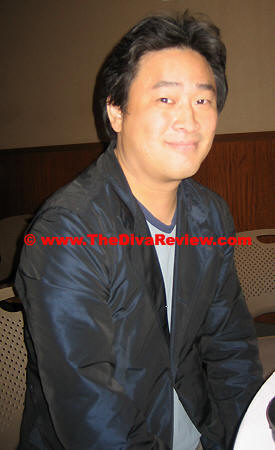 The
Lady Miz Diva: How long has the idea for Thirst been in your head? I
noticed “Evil Live” was the film being shot during you short film, Cut,
from 2004’s Three... Extremes anthology.
The
Lady Miz Diva: How long has the idea for Thirst been in your head? I
noticed “Evil Live” was the film being shot during you short film, Cut,
from 2004’s Three... Extremes anthology.
Chan-wook Park: It’s been exactly ten years now since I first thought of the film. It was during the shoot for JSA {2000’s JSA: Joint Security Area} that I first thought about this film. Just one night was all it took to think about the idea for the film. Of course, at the time, I didn’t have the complete story, I only had a couple of sequences, but I thought one day I’ll make this film and Cut was made with this in mind. When I was making Cut, I was imagining what it would be like to one day in the future to make this film.
Back then, I didn’t exactly know how that film would come out or what kind of film I’d make, but when you see Cut, when the female vampire character sucks the blood of her victim, she doesn’t have fangs, but she has this kind of silver false teeth to punch a hole in the victim and through this very small hole she would drink the victim’s blood. The reason for that back then was because I knew that I wasn’t going to make a film that had all these vampire clichés like fangs and so on, but in the end we didn’t end up using the prop of the silver false fangs because I didn’t feel it went with the film.
Also, back then, I was going to call the film “Evil Live” and that was the title of the film-within-a-film that the director character is making; the title of the film is “The Making of Evil Live.” So, I had the letters for “Evil Live” embroidered on the clothes the film crew is wearing and the caps as well, and I didn’t end up using this for the title of this film.
LMD: Now those caps are a collector’s item.
C-wP: I wear the cap. {Laughs}
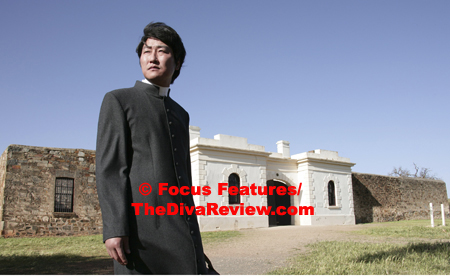 LMD:
In many religions, blood is symbolic for life. I wondered if the
vampirism and the need for blood that the priest goes through wasn’t a
metaphor for punishment for excluding himself from life through his
vows?
LMD:
In many religions, blood is symbolic for life. I wondered if the
vampirism and the need for blood that the priest goes through wasn’t a
metaphor for punishment for excluding himself from life through his
vows?
C-wP: This character of the priest is often grabbed by this desire to kill himself when he finds that his prayers are futile, that they’re not having an effect – although he doesn’t admit this himself in the film. And he confuses this with the desire to become a martyr. That leads him to volunteer for this dangerous biological experiment and through the experiment he becomes a creature that cannot live without killing other people.
So, the blood that he drinks rather than signifying the character’s drinking someone else’s life or life itself, he’s only taking in just enough for his very survival, he takes in the very minimal amount, because for him the act of drinking blood is almost equal to his sense of guilt.
LMD: Where did the idea for the priest lying under the hospital bed drinking from his victim through the IV straw come from?
C-wP: In the process of trying to get rid of all these clichés associated with vampire films, the first step I took was a medical one. The hospital where this priest character works, there are lots of patients there and just the idea of having the priest working at a hospital was proof and point for this approach and also the fact that he volunteers for this biological experiment is also the same.
And also the way that he becomes a vampire is a very, very material or physical one, as opposed to an emotional one; the process is by blood transfusion in a hospital. Once he becomes a vampire, he’s close to this coma patient at the hospital and drinking blood from him, probably was an idea that came to him naturally because there’s not having to fight with your victims to drink their blood, and it’s quite readily available, and there’s no need to feel sorry about taking blood from these comatose patients and no need to murder them.
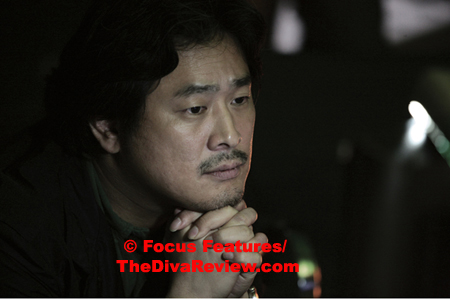 LMD:
Are you fascinated by religion? The whole of Thirst is about a priest
and there are references to scripture in OldBoy. Do you consider
yourself a Catholic?
LMD:
Are you fascinated by religion? The whole of Thirst is about a priest
and there are references to scripture in OldBoy. Do you consider
yourself a Catholic?
C-wP: Well, my parents were Catholics. When I was child I went to church without realising what it was all about, but after puberty, I stopped being a Catholic, so right now I’m not Catholic.
But at the time, when my worldview was being formed at a time when my sensibilities were being developed, I had been going to church every week, so invariably, I feel in some way I must have been affected by the experience.
I did go to a Jesuit university on the strong recommendation of my parents, and what I studied there was philosophy, but what I wanted to study was art or aesthetics. Out of the professors there there were a lot of priests and the only kind of aesthetics I could study at the university was called Scholasticism, these medieval Church arts. Because I could only learn aesthetics within this church’s traditions, I was unhappy, a little discontent. I was limited to learn about medieval church art.
LMD: Were you ever approached by the studios to tone down either the graphic sex or allusions to religion? Is there much censorship in Korean film, or are you in a position where you can do what you like?
C-wP: From time to time, there would be people who are afraid that these aspects would hinder or provide an obstacle for the film from getting released and these concerns would come from people involved in the production.
But despite concerns, there really were no problems in getting the film released. With Oldboy, for instance, my producer was worried that the incest idea and the father and daughter having sex would be a problematic element, or the idea of involving religion would cause an issue, but despite these concerns the films were released all right and it proved their concerns were unfounded.
The thing about it, is these people on the ratings committees, they know that in Oldboy these characters didn’t realise that they related, that they were in a father/daughter relationship, and because they understood this context, there was no problem.
In terms of Thirst, the Korean Catholic church is very open and quite liberal, and so I didn’t have any problems there, either.
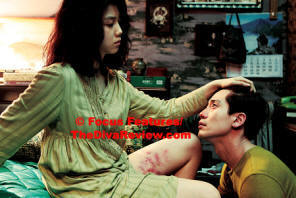 LMD:
Was the graphic sexuality in Thirst meant to shock?
LMD:
Was the graphic sexuality in Thirst meant to shock?
C-wP: The sex scenes are a very important part of the film because this is the moment when as a priest, the main character steps over that line that could not be crossed. It is the moment where he makes the moral downfall for a priest.
For the woman, it is a moment of liberation. She feels this great sense of liberation from this marriage which to her, felt like hell, which to her felt like a prison.
For these two characters it was such an important moment that I just could not say, “And so they had sex.” I just could not do that. Every facial expression, every position and every noise they make and everything that they say, it is very important that you are able to see these details and think about what these moments mean for them.
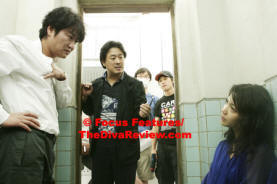 LMD:
Did Song Kang-ho do any sort of training for Thirst? He looks very slim
here. Did you have any hesitation from Song or your lead actress, Kim
Ok-vin regarding how much was going to be shown during the sex scenes?
LMD:
Did Song Kang-ho do any sort of training for Thirst? He looks very slim
here. Did you have any hesitation from Song or your lead actress, Kim
Ok-vin regarding how much was going to be shown during the sex scenes?
C-wP: Of course, Song Kang-ho, he lost weight for the role and he’s thinner. He didn’t have any type of hesitation with these raunchy sex scenes. He’s the type of actor if there’s something that has to be done of the film, he finds it a shame for an actor to say no, or to shy away from what is required for the film.
As a Korean woman, Kim Ok-vin, she was more shy about the fact that there are these scenes, but in this instance, she already had an expectation of what level of sex scenes that would be involved in doing this film. It was one of the things that I talked to her about from the outset. I’m the kind of director that storyboards everything in a movie and of course that involved the sex scene as well, so I showed her the storyboard and she knew exactly what was involved with these scenes. So, there was a choice from the onset, ‘You know all about what’s involved with respect to the sex scenes, if you want to do it, you can do it, if not leave it.’
So, there wasn’t any convincing involved or anything like that. It was a simple choice whether or not she took it as a whole package.
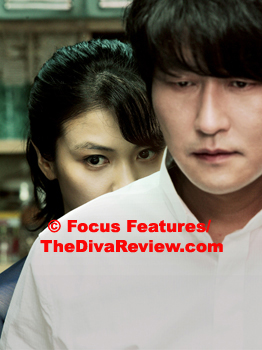 LMD:
What would you like for audiences to take away from Thirst/Bakjwi?
LMD:
What would you like for audiences to take away from Thirst/Bakjwi?
C-wP: I would like audiences to think about this character of the priest: Even though he didn’t ask to become a vampire, now he is a vampire and living as a vampire. Now, should he feel a sense of guilt because of this? Should he feel guilty about living as a vampire, even though he didn’t ask or choose to become a vampire? Is it right for him to feel this sense of guilt is something that I’d like audiences to ask themselves after having seen Thirst.
~ The Lady Miz Diva
July 28th, 2009
Special thanks to Wonjo Jeong of Moho Film for his wonderful translation.
© 2006-2022 The Diva Review.com
|
|